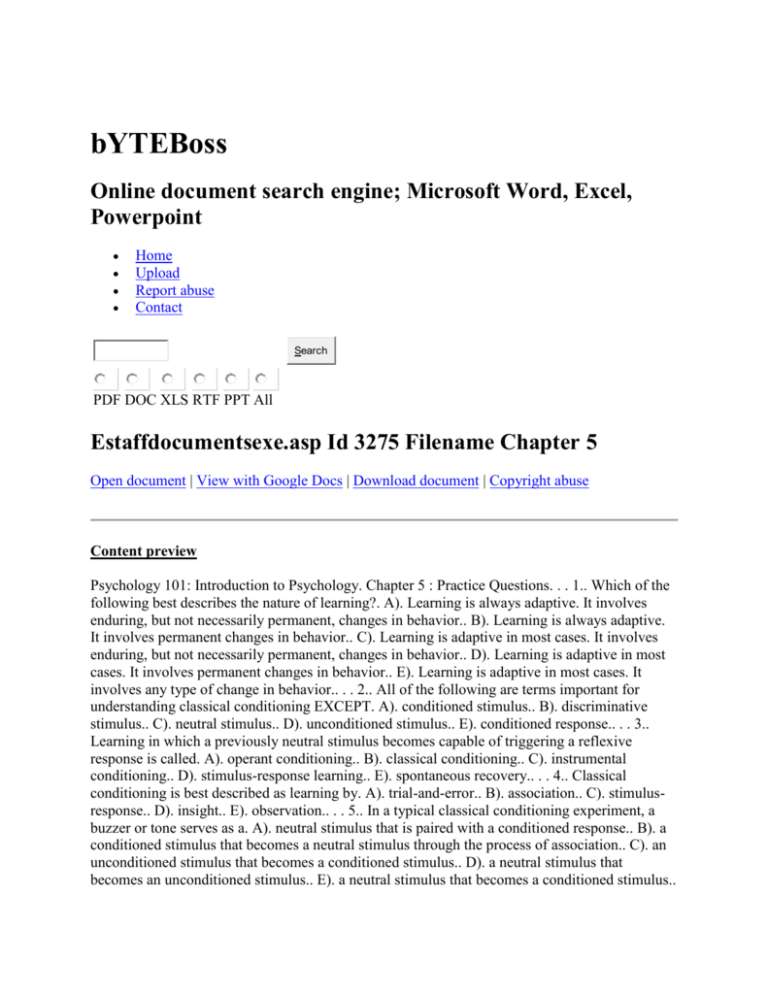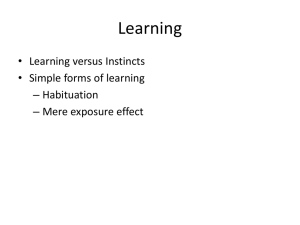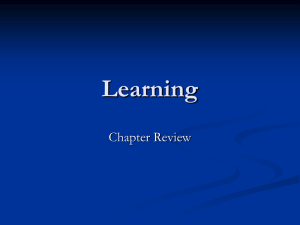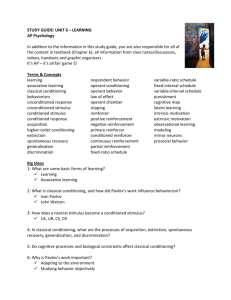Psychology 101: Introduction to Psychology
advertisement

bYTEBoss Online document search engine; Microsoft Word, Excel, Powerpoint Home Upload Report abuse Contact Search PDF DOC XLS RTF PPT All Estaffdocumentsexe.asp Id 3275 Filename Chapter 5 Open document | View with Google Docs | Download document | Copyright abuse Content preview Psychology 101: Introduction to Psychology. Chapter 5 : Practice Questions. . . 1.. Which of the following best describes the nature of learning?. A). Learning is always adaptive. It involves enduring, but not necessarily permanent, changes in behavior.. B). Learning is always adaptive. It involves permanent changes in behavior.. C). Learning is adaptive in most cases. It involves enduring, but not necessarily permanent, changes in behavior.. D). Learning is adaptive in most cases. It involves permanent changes in behavior.. E). Learning is adaptive in most cases. It involves any type of change in behavior.. . . 2.. All of the following are terms important for understanding classical conditioning EXCEPT. A). conditioned stimulus.. B). discriminative stimulus.. C). neutral stimulus.. D). unconditioned stimulus.. E). conditioned response.. . . 3.. Learning in which a previously neutral stimulus becomes capable of triggering a reflexive response is called. A). operant conditioning.. B). classical conditioning.. C). instrumental conditioning.. D). stimulus-response learning.. E). spontaneous recovery.. . . 4.. Classical conditioning is best described as learning by. A). trial-and-error.. B). association.. C). stimulusresponse.. D). insight.. E). observation.. . . 5.. In a typical classical conditioning experiment, a buzzer or tone serves as a. A). neutral stimulus that is paired with a conditioned response.. B). a conditioned stimulus that becomes a neutral stimulus through the process of association.. C). an unconditioned stimulus that becomes a conditioned stimulus.. D). a neutral stimulus that becomes an unconditioned stimulus.. E). a neutral stimulus that becomes a conditioned stimulus.. . . 6.. Pavlov found that the strength of a conditioned response increased with the number of pairings of the. A). CR and UR.. B). CS and US.. C). CS and CR.. D). CS and UR.. E). CR and US.. . . 7.. Dr. Emmanuel demonstrates a classical conditioning experiment for his psychology class. Emmanuel pairs a neutral stimulus with an unconditioned stimulus and then asks the class, “What is the neutral stimulus called now?― The correct answer is. A). conditioned response.. B). conditioned stimulus.. C). reinforcer.. D). conditioned reinforcer.. E). unconditioned response.. . . 8.. A puff of air to the eye causes a reflexive blink. If you precede the puff of air with a buzzer, eventually the buzzer will cause a blink. In this example, the puff of air is the. A). unconditioned stimulus.. B). conditioned stimulus.. C). neutral stimulus.. D). unconditioned response.. E). conditioned response.. . . 9.. Which pattern best describes what happens once classical conditioning occurs?. A). UR elicits the US.. B). CS elicits the CR.. C). NS leads to no response.. D). NS + US leads to UR.. E). US + CS leads to UR.. . . 10.. In classical conditioning, a conditioned response can weaken and eventually disappear. This is referred to as. A). spontaneous recovery.. B). generalization.. C). discrimination.. D). reconditioning.. E). extinction.. . . 11.. Which of the following is the best definition of spontaneous recovery?. A). The weakening and disappearance of a conditioned response over time. B). Displaying a conditioned response to stimuli similar to the conditioned stimulus. C). Displaying a conditioned response to new neutral stimuli. D). Displaying a conditioned response in the absence of the conditioned stimulus. E). Return of a conditioned response following extinction. . . 12.. Following his experience in the military, Hans developed a classically conditioned fear response to radio static. After he left the military, the response extinguished. However, after not hearing radio static for several months, Hans again shows the conditioned fear response. Hans's experience is a demonstration of. A). stimulus generalization.. B). stimulus discrimination.. C). reconditioning.. D). spontaneous recovery.. E). shaping.. . . 13.. Following extinction, a conditioned response can be learned again more quickly than it was learned originally. This process is called. A). spontaneous recovery.. B). generalization.. C). discrimination.. D). reconditioning.. E). shaping.. . . 14.. Stimulus generalization occurs when. A). the conditioned response reappears after extinction.. B). the conditioned response is displayed following exposure to stimuli that resemble the conditioned stimulus.. C). the conditioned response is not displayed following presentation of the conditioned stimulus.. D). the conditioned stimulus elicits responses that are generally like the conditioned response.. E). the conditioned stimulus generalizes to other settings.. . . 15.. LaGina walks into a room and feels as if she has been there before, even though she knows that she has not. LaGina's experience of deja vu may be explained by which concept from classical conditioning?. A). Extinction. B). Stimulus generalization. C). Stimulus discrimination. D). Spontaneous recovery. E). Reconditioning. . . 16.. Through classical conditioning, Alyce has developed a fear of mice. She also shows a fear response to gerbils and hamsters. Alyce is demonstrating. A). stimulus generalization.. B). stimulus discrimination.. C). spontaneous recovery.. D). extinction.. E). reconditioning.. . . 17.. Through classical conditioning, Eduardo has developed a fear of dogs. However, he only fears large, longhaired dogs but not small, longhaired dogs or large, shorthaired dogs. Eduardo is demonstrating. A). spontaneous recovery.. B). stimulus discrimination.. C). stimulus generalization.. D). latent learning.. E). extinction.. . . 18.. Increasing the number of pairings of the US and CS will. A). weaken the CR.. B). strengthen the CR.. C). weaken the CR at first, and then strengthen it.. D). strengthen the CR at first, and then weaken it.. E). have no effect on the CR.. . . 19.. In the past three psychology labs, Liliya has been attempting to classically condition a lab rat. Her strategy has been to present the US and CS simultaneously. Which of the following should she do to strengthen the conditioned response of the rat?. A). Make less frequent pairings of CS and US.. B). Present the CS first and have it remain present during presentation of US.. C). Present the US prior to CS.. D). Present the CS first and withdraw it before introducing the US.. E). Decrease the intensity of the US.. . . 20.. Rescorla's view of classical conditioning focuses on the extent to which the CS __________ the US.. A). interferes with. B). predicts. C). follows. D). reduces. E). is elicited by. . . 21.. Watson investigated the classical conditioning of which type of responses?. A). Anger. B). Sadness. C). Happiness. D). Fear. E). Sexual arousal. . . 22.. In Watson's research with Little Albert, what was the CS?. A). A loud sound. B). A white rat. C). An electric shock. D). A spanking. E). The Santa Claus mask. . . 23.. Under which condition would Watson's experiments on classical conditioning be replicated today?. A). If the researchers obtained parental permission to expose the child to intense fear. B). If the researchers used methods to extinguish the fears after completing their experiments. C). If the researchers followed the children for several years to make sure they were not “damaged― from their participation in the experiment. D). If the researchers taught parents how to extinguish their children's fears. E). The experiments would not be replicated even with the parents' permission. . . 24.. Classical conditioning can explain the development of all of the following EXCEPT. A). aversions to particular foods.. B). phobias.. C). positive or negative emotions.. D). drug cravings during withdrawal.. E). complex, voluntary behaviors.. . . 25.. Although Little Albert was classically conditioned to fear a rat, he also began to fear dogs, rabbits, and a Santa Claus mask. This is an example of. A). spontaneous recovery.. B). stimulus generalization.. C). stimulus discrimination.. D). extinction.. E). reconditioning.. . . 26.. A researcher finds that rats avoid drinking from bottles in a room in which they had received exposure to radiation that subsequently made them ill. This demonstrates. A). stimulus discrimination.. B). stimulus generalization.. C). conditioned taste aversion.. D). fixed interval schedule of reinforcement.. E). behavior therapy.. . . 27.. Summarize how classical conditioning is achieved.. . . 28.. The Law of Effect was proposed by. A). Pavlov.. B). Skinner.. C). Thorndike.. D). Watson.. E). Tolman.. . . 29.. Thorndike is to _____ as Skinner is to _______.. A). classical conditioning; Law of Effect. B). classical conditioning; operant conditioning. C). operant conditioning; classical conditioning. D). Law of Effect; classical conditioning. E). Law of Effect; operant conditioning. . . 30.. Operant conditioning is also known as. A). classical conditioning.. B). vicarious learning.. C). observational learning.. D). instrumental learning.. E). cognitive learning.. . . 31.. Which of the following is an example of negative reinforcement?. A). A mother picks up her infant when he cries, which then stops his crying, thereby reducing the mother's level of annoyance.. B). A father picks up his infant when she cries, thereby increasing the likelihood that she will cry to be picked up again in the future.. C). A grandmother gives her granddaughter a “time out― when she misbehaves, thereby leading the granddaughter to calm down.. D). A grandfather gives his grandson $10 for every “A― on his report card, thereby strengthening his grandson's study habits.. E). A caregiver removes a child from the “block play center― when he is throwing blocks, thereby causing him to cry.. . . 32.. Zorba gives his dog a treat for rolling over. Zorba is using. A). conditioned reinforcement.. B). punishment.. C). negative reinforcement.. D). positive reinforcement.. E). classical conditioning.. . . 33.. Velma takes headache medicine to relieve pain. The medicine serves to remove the pain. This is an example of. A). avoidance conditioning.. B). conditioned reinforcement.. C). positive reinforcement.. D). negative reinforcement.. E). superstitious behavior.. . . 34.. Primary reinforcers are. A). the first reinforcers an animal learns.. B). the most powerful reinforcers an animal learns.. C). intrinsically rewarding.. D). reinforcers that are learned through classical conditioning.. E). also called conditioned reinforcers.. . . 35.. All but which of the following are primary reinforcers?. A). Money. B). Sexual stimulation. C). Novel visual stimuli. D). Air, food, and water. E). Relief from pain. . . 36.. Researchers use the method of successive approximations in the process of. A). insight learning.. B). higher-order conditioning. . C). conditioning taste aversions.. D). shaping.. E). extinction.. . . 37.. Which of the following is demonstrating extinction of an operant response?. A). Ginny, who learns to dress herself when her mother reinforces her for accomplishing each small step in the process. B). Ron, who receives praise every time he puts his schoolbooks away. C). Hermione, who eventually stops raising her hand when Professor Snape fails to call on her. D). Harry, who learns secret routes that provide an escape from the Dark Forest when he is under attack. E). Malfoy, who leaves school two days early at Christmas break to avoid the rush of holiday traffic. . . 38.. Vlad receives $100 for every ten telemarketing calls he makes. This is an example of a ______ schedule of reinforcement.. A). fixed ratio. B). variable ratio. C). fixed interval. D). variable interval. E). 100/10. . . 39.. The rats in Dr. Rexington's learning laboratory are on an “FR-7― schedule of reinforcement. What does this mean?. A). The rats will receive a food pellet after every seventh bar press.. B). The rats will receive a food pellet after an average of every seven bar presses.. C). The rats will receive a food pellet every seven minutes.. D). The rats will receive a food pellet an average of every seven minutes.. E). The rats will receive a food pellet every seven minutes, unless they press the bar seven times in a shorter period of time.. . . 40.. A child receives a dime for, on average, every 5 dandelions he pulls from the yard. This is an example of a ______ schedule of reinforcement.. A). fixed ratio. B). variable ratio. C). fixed interval. D). variable interval. E). continuous reinforcement. . . 41.. Which of the following best describes charted data for a variable interval schedule of reinforcement?. A). Slight dip in responses after reinforcement. B). Slow, steady rate of response. C). Responses decrease after an initial steep increase. D). Fast, steady rates of response. E). Responses pause after each reinforcement. . . 42.. A schedule of reinforcement in which the first response performed after a specific amount of time has passed is reinforced is called a. A). fixed-ratio schedule.. B). fixed-interval schedule.. C). variable-interval schedule.. D). variable-ratio schedule.. E). continuous reinforcement schedule.. . . 43.. Regarding punishment, which of the following statements is FALSE?. A). Psychologists and pediatricians encourage parents not to rely on punishment as a primary means of discipline.. B). Punishment can involve the presentation of an unpleasant stimulus.. C). Punishment can involve the removal of a reinforcing stimulus.. D). Punishment can be considered the flip side of reinforcement.. E). Negative reinforcement is the technical term for punishment.. . . 44.. Amita was just grounded by her parents. She is not allowed to use her computer or cell phone, or watch television. Which method of punishment are Amita's parents using?. A). Token economy. B). Removal of a reinforcer. C). Verbal reprimand. D). Time-out. E). Removal of a negative reinforce. . . 45.. ______ is the systematic application of operant conditioning to strengthen adaptive behavior and weaken maladaptive behavior.. A). Biofeedback. B). Behavior modification. C). Token economy. D). Shaping. E). Programmed instruction. . . 46.. All but which of the following are examples of the application of principles of operant conditioning?. A). Biofeedback training. B). Computer-assisted instruction. C). Conditioned immune system responses. D). Programmed instruction. E). Token economies. . . 47.. ______ is learning that occurs without the opportunity of first performing the learned response or being reinforced for it.. A). Operant conditioning. B). Higher-order conditioning. C). Classical conditioning. D). Creative learning. E). Cognitive learning. . . 48.. Caroline has an “Aha!― experience when solving a problem. Caroline most likely experienced which type of learning?. A). Latent learning. B). Insight learning. C). Observational learning. D). Operant conditioning. E). Classical conditioning. . . 49.. Learning that occurs without apparent reinforcement and is not revealed in performance when it occurs is referred to as. A). insight learning.. B). classical conditioning.. C). spontaneous recovery.. D). latent learning.. E). shaping.. . . Answer Key. . 1.. C. 2.. B. 3.. B. 4.. B. 5.. E. 6.. B. 7.. B. 8.. A. 9.. B. 10.. E. 11.. E. 12.. D. 13.. D. 14.. B. 15.. B. 16.. A. 17.. B. 18.. B. 19.. B. 20.. B. 21.. D. 22.. B. 23.. E. 24.. E. 25.. B. 26.. C. 27.. Classical conditioning involves learning an association between two stimuli. It makes use of a pre-existing reflexive response. For example, a puff of air into the eye causes a blink. The puff of air is the unconditioned stimulus (US) and the blink is the unconditioned response (UR). A different, neutral stimulus (NS) such as a tone is presented in conjunction with the US. After several combinations, the US can be withdrawn and the blink is elicited by the tone alone. At this point, the tone is the conditioned stimulus (CS) and the blink is the conditioned response (CR).. 28.. C. 29.. E. 30.. D. 31.. A. 32.. D. 33.. D. 34.. C. 35.. A. 36.. D. 37.. C. 38.. A. 39.. A. 40.. B. 41.. B. 42.. B. 43.. E. 44.. B. 45.. B. 46.. C. 47.. E. 48.. B. 49.. D. . . Search Wikipedia for eStaffDocumentsEXE.asp?id=3275&filename=Chapter 5 Search Bing for eStaffDocumentsEXE.asp?id=3275&filename=Chapter 5 Search Google for eStaffDocumentsEXE.asp?id=3275&filename=Chapter 5 Latest files Facilities Inspection Services Eastbay.pdf Facilities Inspection Services East Bay Aluminum Scaffold Bay Area.pdf Scaffolding Company, Aluminum Scaffold Bay Area Solar Farm Developers.pdf Solar Farm Developers Biotechnology Company San Francisco Bay Area.pdf Newomics BioTechnology Company San Francisco Bay Area Italfood Water Guide.pdf Importer & Wholesalers of Selected of Foreign and Domestic Food Products Deck Refinishing Walnutcreek.pdf AllproDeck,complete resource for Deck Refinishing, Interior and Exterior Painting, Deck Restoration, Power Washing in Walnut Creek,California. Light Duty Towing Roadside Assistance.pdf Action Towing & Road Service complete resource for Heavy & Medium Duty Towing, Light Duty Towing in California. Chocolate Ptca Balloon Catheter.pdf QTVascular,Innovative in Minimally Invasive Treatment for Vascular Disease Treatment product includes Balloon Catheters. Centrifugal Pumps Reliability.pdf Price Pump,Pump Manufacturer in California complete resource for Magnetically Driven Centrifugal Pumps, Close Coupled Centrifugal Pumps, Vertical Centrifugal Pumps, Air Operated Diaphragm(AOD) Pumps. Executive Search Firms San Francisco Bay Area.pdf Hager Executive Search,complete resource for Executive Search Firms in San Francisco Bay Area. Website thumbnail Thumbnail provided by www.webthumbnail.com Recommended Week 2 o Week 2. Tiny Tots. Long Jump. Under 6. Triple Jum o 8Helloworld Final Learning Objectives This module will help you... KLEIN.CV . CURRICULUM VITAE. . . . ROBERT S. KLEIN, M.D.. Robertson Workers Compensation and Group Health Workers Co Planet Sheet3. Sheet2. Sheet1. delta_t. G. k. v_x_init. 4301 State Superintendent PRSDNT96. Print_Area_MI. Pprfsc Oprs Fy2009 fsc. PrintArea. Title. FY-04. FY-05. FY-06. FY-07 assignments riskAnalysisAssignment. ganttAssignment (b). gant MungeliS.K.LIST28.07.2013 27.07.13 final ExSCIENCE (3). 27.07.13 Final Exi Esquema. 10 De Junio 2012. Jesus. Rafael.restringido Copia De Xl0000007 2 o Hoja2. Hoja1. Hora / Fecha. 8:00 a 10:00 a.m.. Eu o CLASPPRES ENTATION 111 Contin uous Learni ng for Admin istrator s of S Shine Studen tday Viall I n h e r e n t L e n g t h S c a l e s a n d A p p a r e n t F r e q u e n c i e s o A G l a s s C a n O n l y S p i l l W h a t I t C o n t a i n s A G l a s s C a n O n l y S p i l l W h a t I t C o n t a i n s A s o n g b W a k h u n g u S T S e m i n a r N o v 2 9 No thanks









